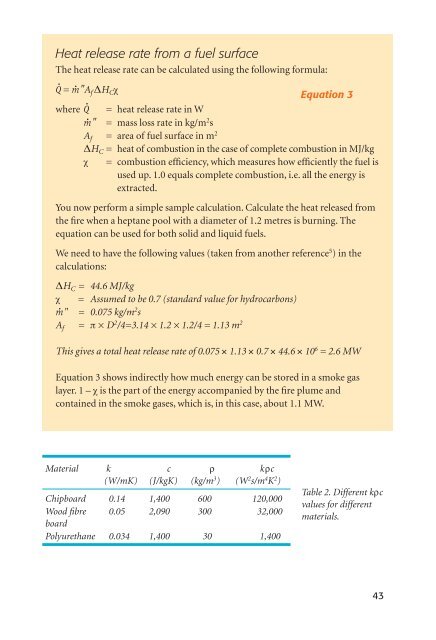You also want an ePaper? Increase the reach of your titles
YUMPU automatically turns print PDFs into web optimized ePapers that Google loves.
Heat release rate from a fuel surface<br />
The heat release rate can be calculated using the following formula:<br />
Q = m"A f DH Cx<br />
where Q = heat release rate in W<br />
m" = mass loss rate in kg/m 2 s<br />
A f = area of fuel surface in m 2<br />
DH C = heat of combustion in the case of complete combustion in MJ/kg<br />
x = combustion effi ciency, which measures how effi ciently the fuel is<br />
used up. 1.0 equals complete combustion, i.e. all the energy is<br />
extracted.<br />
You now perform a simple sample calculation. Calculate the heat released from<br />
the fi re when a heptane pool with a diameter of 1.2 metres is burning. The<br />
equation can be used for both solid and liquid fuels.<br />
We need to have the following values (taken from another reference 5 ) in the<br />
calculations:<br />
DHC = 44.6 MJ/kg<br />
x = Assumed to be 0.7 (standard value for hydrocarbons)<br />
m" = 0.075 kg/m2s Af = p × D2 /4=3.14 × 1.2 × 1.2/4 = 1.13 m2 Equation 3<br />
This gives a total heat release rate of 0.075 × 1.13 × 0.7 × 44.6 × 10 6 = 2.6 MW<br />
Equation 3 shows indirectly how much energy can be stored in a smoke gas<br />
layer. 1 – x is the part of the energy accompanied by the fi re plume and<br />
contained in the smoke gases, which is, in this case, about 1.1 MW.<br />
Material k<br />
(W/mK)<br />
c<br />
(J/kgK)<br />
3<br />
(kg/m 3 )<br />
k3c<br />
(W 2 s/m 4 K 2 )<br />
Chipboard 0.14 1,400 600 120,000<br />
Wood fi bre<br />
board<br />
0.05 2,090 300 32,000<br />
Polyurethane 0.034 1,400 30 1,400<br />
Table 2. Different k3c<br />
values for different<br />
materials.<br />
43

















